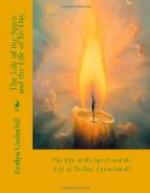This question, often put in the crucial form, “Did Jesus Christ intend to form a Church?” is well worth asking. Indeed, it is of great pressing importance to those who now have the spiritual reconstruction of society at heart. It means, in practice: can men best be saved, regenerated, one by one, by their direct responses to the action of the Spirit; or, is the life of the Spirit best found and actualized through submission to tradition and contacts with other men—that is, in a group or church? And if in a group or church, what should the character of this society be? But we shall make no real movement towards solving this problem, unless we abandon both the standpoint of authority, and that of naive religious individualism; and consent to look at it as a part of the general problem of human society, in the light of history, of psychology, and of ethics.
I think we may say without exaggeration that the general modern judgment—not, of course, the clerical or orthodox judgment—is adverse to institutionalism; at least as it now exists. In spite of the enormous improvement which would certainly be visible, were we to compare the average ecclesiastical attitude and average Church service in this country with those of a hundred years ago, the sense that religion involves submission to the rules and discipline of a closed society—that definite spiritual gains are attached to spiritual incorporation—that church-going, formal and corporate worship, is a normal and necessary part of the routine of a good life: all this has certainly ceased to be general amongst us. If we include the whole population, and not the pious fraction in our view, this is true both of so-called Catholic and so-called Protestant countries.




